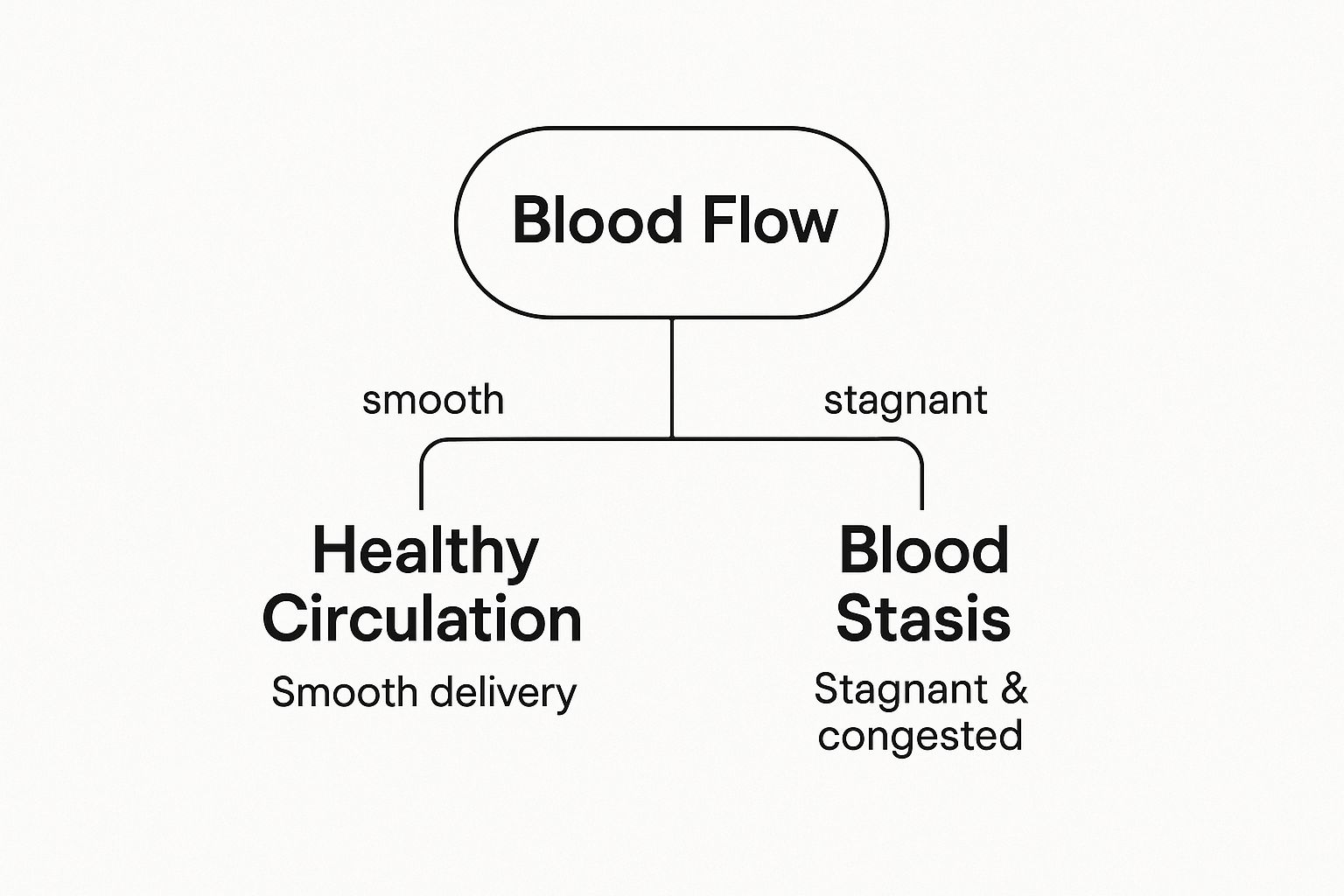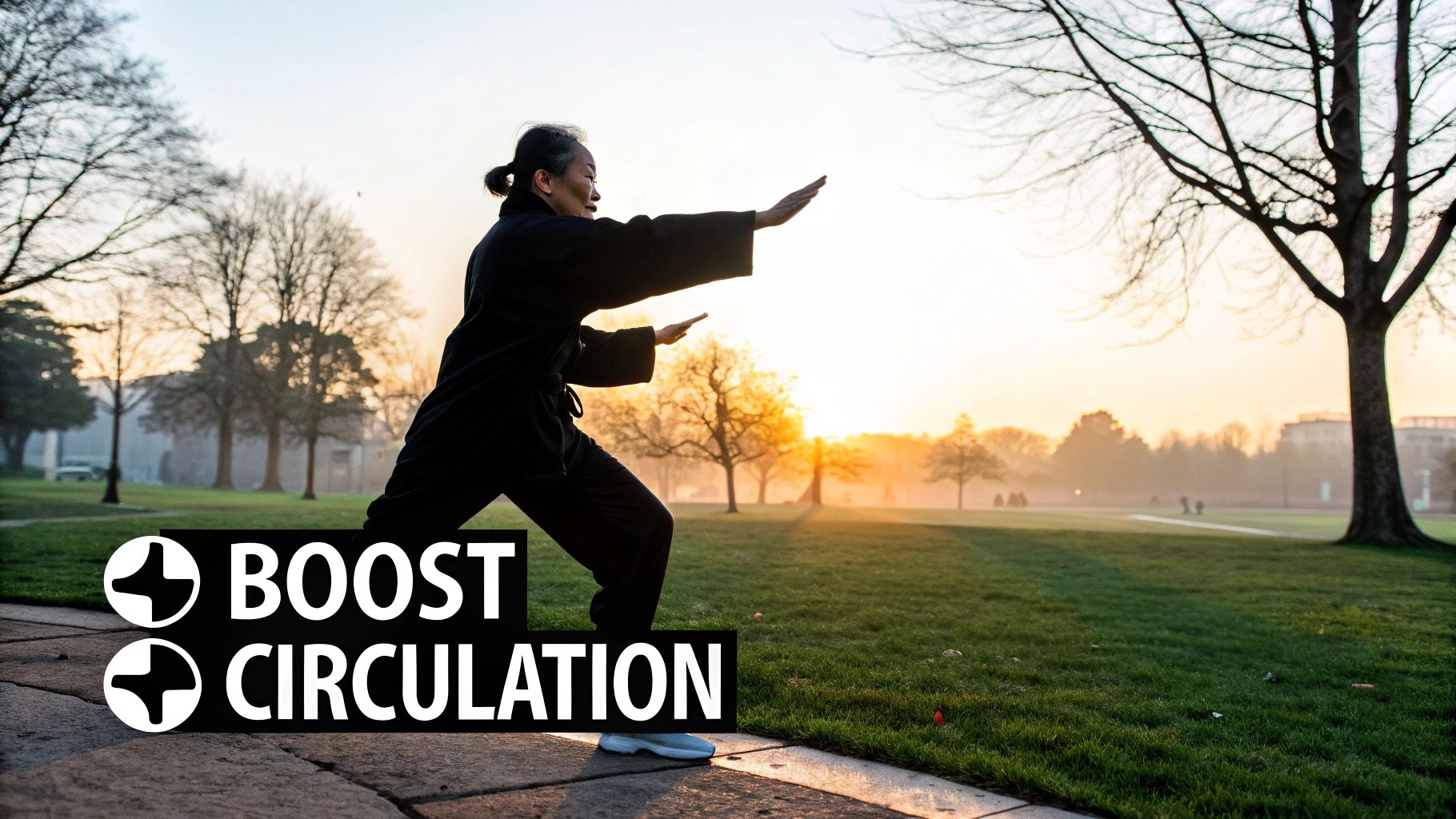In the world of Traditional Chinese Medicine (TCM), the concept of blood stasis is central to understanding many health imbalances. Put simply, it’s when blood isn't flowing the way it should. Instead of circulating freely to nourish every corner of your body, its movement becomes sluggish, congested, or even completely stuck.
This internal traffic jam can be the root cause of many types of pain and a wide range of other health problems.
Understanding Blood Stasis With The River Analogy
To really get a feel for what blood stasis is, imagine your circulatory system is a vibrant, flowing river.
When you’re healthy, that river runs smoothly and consistently. It carries life-giving water, oxygen, and nutrients to the entire landscape, allowing everything along its banks to thrive. This is the picture of a healthy circulatory system—unobstructed, efficient, and full of vitality.
But what happens if a dam is built, or debris like fallen logs and silt starts to clog the river's path? The flow slows down. The water becomes stagnant and murky, and it can no longer deliver what the surrounding ecosystem needs to flourish. This blockage is the perfect metaphor for blood stasis in TCM. It’s a disruption that prevents blood from doing its vital job, starving tissues and organs of the nourishment they need.
This infographic helps visualize the stark difference between a system that flows freely and one that's become blocked.

As you can see, it's a clear contrast between dynamic movement and congested obstruction—the core of what separates health from imbalance in this TCM model.
Healthy Flow Versus Stagnation
The difference between healthy circulation and blood stasis couldn't be more critical. One sustains life and vitality, while the other can set the stage for chronic discomfort and disease. It's not just about how fast your blood moves, but about the quality and efficiency of its journey through the body.
To make this even clearer, let's break down the river analogy in a table.
Understanding Blood Stasis With The River Analogy
| Concept | Healthy Circulation (A Flowing River) | Blood Stasis (A Blocked River) |
|---|---|---|
| Movement | Blood flows smoothly and consistently, like a steady current. | Blood movement is slow, congested, or completely obstructed. |
| Nourishment | Tissues and organs receive a constant supply of oxygen and nutrients. | Nourishment is impaired, leading to potential dysfunction or pain. |
| Appearance | Complexion is vibrant; tongue and nails have a healthy pinkish color. | The tongue, lips, or nails may appear purplish or dark. |
| Pain Sensation | Absence of fixed, persistent pain related to circulation. | Pain is often fixed in one location and may feel sharp or stabbing. |
Grasping this fundamental contrast is the first step toward understanding why TCM places such a high value on maintaining "free flow." Just as a stagnant river negatively impacts its entire environment, stagnant blood can throw your body's delicate internal balance out of whack.
Ultimately, the goal of many TCM therapies is to act like a crew clearing a logjam—to remove the obstruction, break down the "dam," and restore the river's natural, life-sustaining current.
The Ancient Roots of Blood Stasis in TCM
The idea of blood stasis isn't some new-age health fad. Far from it. Its origins are woven into the very fabric of Traditional Chinese Medicine (TCM), with detailed descriptions found in classical texts dating back more than a thousand years. Ancient physicians recognized a clear pattern: when blood couldn't flow freely, it often became the root cause of many stubborn and chronic health problems.
In their eyes, blood stasis was never just a standalone issue. It was almost always the physical result of a deeper, more subtle imbalance. The most common culprit? Qi stagnation, a state where the body's vital life force, or Qi, gets stuck.
The Unbreakable Bond Between Qi and Blood
In TCM, Qi and blood are inseparable partners. You can think of Qi as the invisible energy that gives blood its momentum, pushing it through the vessels. Blood, in turn, is the dense, nourishing substance that gives Qi a physical anchor. One simply can't function without the other.
There's a foundational saying in Traditional Chinese Medicine: "If there is free flow, there is no pain; if there is no free flow, there is pain." This simple but profound concept underscores just how crucial unimpeded movement is for both Qi and blood to maintain health.
When Qi gets bogged down—often from emotional stress, an old injury, or even just poor lifestyle habits—it can't do its job of moving the blood effectively. The blood starts to slow down, pool, and eventually thicken. This is the very definition of blood stasis. It's why a TCM practitioner often focuses on getting your Qi moving again to resolve issues with blood circulation. To dive deeper into this, you can read our guide explaining what is Qi in Chinese medicine.
From Ancient Wisdom to Modern Science
For centuries, the concept of blood stasis syndrome (BSS) was a diagnostic tool used almost exclusively within TCM. Now, this ancient framework is capturing the attention of modern scientific researchers, who are keen to connect this historical wisdom with contemporary medical science.
This wave of interest really started picking up in the late 1980s, led by scholars in China. A bibliometric analysis of publications between 1989 and 2015 showed a dramatic spike in studies on BSS. But it hasn't been a completely smooth road. One of the main hurdles is that the diagnostic criteria for BSS aren't globally standardized, which makes comparing results from different studies a real challenge. You can explore the full analysis of research trends in blood stasis syndrome to see how the field is navigating these complexities.
This ongoing research marks an exciting convergence of past and present. It's beginning to validate the clinical observations that TCM practitioners have made for generations, while also opening up new ways to understand chronic disease. The age-old idea that stagnant blood is at the heart of many persistent health issues is finally being examined through a modern scientific lens, confirming its relevance in both traditional and integrative medicine today.
Recognizing the Signs of Blood Stasis

Understanding the theory of blood stasis is one thing, but spotting it in your own body is another skill entirely. The good news is that the signs are often quite tangible and specific. They usually move beyond a vague feeling of being "off" and present distinct physical clues.
Learning to recognize these patterns can empower you to ask the right questions and have more informed conversations with your healthcare providers.
Blood stasis reveals itself in ways that are directly linked to poor circulation. Imagine a traffic jam on a major highway; the backup creates problems far and wide. The most common indicators generally fall into three categories: pain, visible changes to the body, and disruptions to bodily functions like menstruation.
The Hallmark Sign: Pain That Is Fixed and Sharp
Perhaps the most defining characteristic of blood stasis is a very specific type of pain. It’s not the dull, achy, or wandering discomfort you might feel from Qi stagnation. Instead, blood stasis pain is typically described as fixed, sharp, or stabbing.
This pain doesn't move around—it stays in one place because the blockage itself is localized. You might be able to point to a precise spot on your lower back, abdomen, or chest that consistently hurts. This is your body’s alarm bell, signaling that a particular area isn't getting the smooth, nourishing flow of blood it needs. This kind of persistent, pinpoint pain is a major red flag for blood stasis.
Visible Clues on the Body's Surface
When blood isn't circulating freely, the evidence often appears right on the surface. Deoxygenated, stagnant blood can give a distinct purplish or dark hue to certain areas of the body.
Common visible signs include:
- A Dusky or Purplish Complexion: The face might lose its vibrant tone and take on a slightly dark or purplish cast.
- Dark Lips or Nails: Instead of a healthy pink, lips and nail beds can appear purplish or even bluish.
- A Purple Tongue: In TCM, the tongue is considered a map of the body’s internal health. A purplish tongue, especially with dark spots on the sides or underneath, is a classic sign of blood stasis.
- Varicose or Spider Veins: These twisted, visible veins are a direct result of blood pooling and stagnating, most commonly in the legs.
These physical markers are clear visual cues that blood is getting stuck in the surface tissues instead of flowing smoothly.
Menstrual and Reproductive Health Issues
For women, the menstrual cycle offers a clear window into the state of their blood circulation. The uterus is rich in blood vessels, so any impairment in flow can become especially obvious during menstruation.
Blood stasis is often a primary factor in gynecological conditions like endometriosis, uterine fibroids, and ovarian cysts. The localized, fixed pain and accumulation of tissue associated with these conditions align perfectly with the TCM model of stagnation.
Key menstrual signs of blood stasis include:
- Painful Periods (Dysmenorrhea): This isn't just mild cramping. The pain is often severe, stabbing, and located in a fixed spot in the lower abdomen or back.
- Dark Menstrual Blood: The blood may appear dark purple, brownish, or almost black.
- Large, Dark Clots: The presence of significant clotting is a tell-tale sign that blood is congealing instead of flowing smoothly out of the uterus.
To help you connect these symptoms to different areas of the body, here is a simple breakdown.
Common Symptoms of Blood Stasis by Body System
This table organizes typical symptoms by the affected area, showing how a single underlying pattern can manifest in diverse ways throughout the body.
| Body System | Primary Symptoms | TCM Explanation |
|---|---|---|
| Head & Mind | Fixed headaches or migraines, dizziness, poor memory, insomnia. | Stagnant blood obstructs the flow of clear Qi and blood to the brain, disrupting normal cognitive function. |
| Cardiovascular | Chest pain (angina), palpitations, a feeling of oppression in the chest. | Blood stasis in the chest (Heart vessel obstruction) directly impairs the function of the Heart and circulation. |
| Gynecological | Painful periods with dark clots, endometriosis, fibroids, amenorrhea (no period). | The Uterus (Bao Gong) relies on free-flowing blood. Stagnation leads to pain, masses, and irregular cycles. |
| Musculoskeletal | Chronic, fixed pain in joints or muscles, stubborn pain from old injuries, arthritis. | Blood stagnation prevents proper nourishment and healing of tissues, leading to persistent, localized pain. |
| Skin | Purplish skin discolorations, varicose veins, spider veins, non-healing sores, dry/scaly skin. | Poor circulation in the superficial layers of the body manifests as visible changes and impaired tissue repair. |
| Digestive | Sharp, fixed abdominal pain, palpable masses in the abdomen, hemorrhoids. | Stagnation in the Spleen and Liver systems can obstruct the digestive tract, leading to pain and physical masses. |
Recognizing these patterns is the first step. If you notice a combination of these signs—such as fixed pain paired with a purplish tongue or difficult periods—it indicates that an underlying circulatory imbalance may need to be addressed.
Beyond these main categories, issues like hard abdominal masses or certain types of chest pain can be linked to this pattern. A trained practitioner will look at the full picture of your symptoms, including a detailed analysis of your pulse. To get a better sense of this diagnostic art, you can learn more about Chinese medicine pulse diagnosis and how it reveals the body's internal state.
Understanding the Root Causes of Blood Stasis

Blood stasis isn't something that just happens overnight. It's the end result of underlying imbalances that have been slowly chipping away at the body's natural circulatory rhythm. Think of it like a slow-moving traffic jam on the highway; it doesn't just appear out of thin air. It’s caused by a series of smaller problems—a stalled car here, a closed lane there—that eventually bring everything to a grinding halt.
In the world of Traditional Chinese Medicine (TCM), several key culprits are known to obstruct the free flow of blood. These internal and external factors can work alone or team up, creating the perfect storm for stagnation to set in. Getting to know these root causes is the first and most critical step toward addressing the problem at its source, rather than just playing whack-a-mole with symptoms.
Qi Stagnation: The Main Precursor
More often than not, the trail of blood stasis leads back to Qi stagnation. In TCM, Qi is the vital energy, the very force that powers every function in our body—and that includes propelling blood through our vessels. It's simple: when Qi flows smoothly, blood flows smoothly. But when Qi gets stuck, blood is sure to follow.
So what stops Qi in its tracks? The number one cause is emotional stress. Chronic frustration, unresolved anger, constant worry, and stress create a kind of internal tension that constricts the pathways of Qi. Think about the physical tension you feel when you're stressed—a clenched jaw, tight shoulders. That same clenching happens on the inside, impeding energy flow and, over time, leading to sluggish circulation.
The Impact of Cold and Heat
The environment around us, especially cold, can also play a major role. Just as cold weather can freeze a river solid, exposure to cold can constrict blood vessels and slow down circulation. This can happen from living in a chilly climate, eating too many iced or raw foods, or simply not bundling up enough in the winter. Cold congeals, and that slows everything down.
On the flip side, excessive internal heat can cause a different kind of traffic jam. We're not just talking about temperature here, but about inflammatory processes. This "heat" can essentially cook down the body's fluids, including blood, making it thicker, stickier, and harder to move. It’s a different kind of stagnation, one born from thickness rather than constriction.
Internal Deficiencies That Weaken Flow
Sometimes, the issue isn't an external blockage but an internal weakness. If the body’s overall Qi or Yang energy is running on empty, it simply lacks the horsepower to push the blood effectively. It’s like having weak water pressure in your house; even with perfectly clear pipes, the flow is just a trickle.
In TCM, this is a crucial distinction. Stagnation isn't always caused by a blockage or an "excess" condition. It can also arise from a profound "deficiency," where the fundamental energy required for movement just isn't there to do its job.
This kind of deficiency can be the result of a long-term illness, poor nutrition, or sheer exhaustion, leaving the circulatory system without the momentum it needs to function properly.
Bridging TCM with a Modern Perspective
What's fascinating is how these ancient concepts mirror what modern medicine has discovered. The factors that TCM identifies as the roots of blood stasis align remarkably well with what Western science recognizes as contributors to poor circulation and cardiovascular disease. This synergy gives us a much more complete picture of what's happening.
For example, the TCM idea of Qi stagnation from emotional strain perfectly parallels the modern understanding of how chronic stress and high cortisol levels lead to hypertension and vascular constriction. Both systems agree: our emotional state has a direct, physical impact on our circulation.
Likewise, a sedentary lifestyle—a hallmark of modern life—is a primary cause of what Western medicine calls venous stasis. This is a condition where blood pools in the lower legs due to inactivity, which is a direct, real-world example of the TCM principle that lack of movement breeds stagnation.
This table shows just how closely the two systems describe the same reality, just with different language.
| TCM Root Cause | Modern Medical Parallel | Shared Outcome |
|---|---|---|
| Qi Stagnation (Stress) | Chronic Stress, High Cortisol, Vascular Constriction | Impeded Blood Flow, Hypertension |
| Blood Deficiency | Anemia, Dehydration | Poor Perfusion, Sluggish Flow |
| Cold Invasion | Vasoconstriction from Cold Exposure | Reduced Circulation to Extremities |
| Internal Dampness | Chronic Inflammation, Poor Diet, High Cholesterol | Thickened Blood, Plaque Formation |
| Lack of Movement | Sedentary Lifestyle, Venous Insufficiency | Pooling of Blood, Stagnation |
Ultimately, whether you look at it through an ancient or modern lens, the conclusion is the same: smooth, unimpeded circulation is foundational to good health. Things like emotional well-being, diet, environment, and physical activity aren't just "lifestyle choices"; they are powerful forces that direct the flow of life within us.
How Blood Stasis Connects to Modern Health Conditions
You might be wondering if "blood stasis" is just an ancient, abstract idea. It's not. While the term comes from Traditional Chinese Medicine, the patterns it describes show up constantly in modern health issues we're all familiar with.
Think of TCM and Western medicine as two experts observing the same problem from different angles. They use different languages, but they often point to the same root issues. This connection is key, as it offers a much richer, more complete picture of what's happening in the body. The TCM diagnosis of blood stasis can explain why certain symptoms like sharp pain, discoloration, or fixed lumps appear in a modern medical diagnosis.
Cardiovascular Disease: A Primary Link
The clearest and most researched parallel is in cardiovascular health. When a TCM practitioner hears about chest pain, palpitations, or poor circulation, their mind immediately goes to blood stasis in the chest, clogging the vessels of the Heart.
Take the fixed, stabbing pain of angina, for example—it's a textbook description of blood stasis. In mainland China, this isn't just a theory; it's a fundamental part of integrative clinical practice. In fact, epidemiological surveys have revealed that a staggering 77.89% of coronary heart disease (CHD) cases show signs of blood stasis syndrome.
This strong correlation highlights just how relevant the TCM perspective is for one of the world's leading causes of death. You can learn more about the connection between CHD and blood stasis in detailed clinical studies.
Gynecological and Reproductive Conditions
For many gynecological problems, blood stasis is a foundational diagnosis. It provides a cohesive explanation for a collection of symptoms that might otherwise seem unrelated. Any condition involving fixed growths, masses, or sharp, localized pain is often seen as stagnation in the uterus and its related energy channels.
Here are a few classic examples:
- Endometriosis: The hallmark of endometriosis is severe, stabbing menstrual pain and the growth of uterine tissue elsewhere in the body. From a TCM perspective, this is a direct result of congealed blood that hasn't been properly cleared.
- Uterine Fibroids and Ovarian Cysts: These are seen as tangible, physical accumulations that build up over time due to chronic blood stagnation in the lower abdomen.
- Painful Periods (Dysmenorrhea): When menstrual pain is severe, fixed in one spot, and accompanied by large, dark clots, blood stasis is almost always identified as the main culprit.
In each scenario, the TCM diagnosis zeroes in on the process of stagnation, beautifully complementing the Western diagnosis that focuses on the structural result.
Chronic Pain and Venous Disorders
The concept of blood stasis also offers incredible insight into chronic pain syndromes and circulatory issues, especially in the limbs. When blood flow is blocked or slowed in a particular area, it creates the kind of stubborn, localized pain that defines so many frustrating conditions.
The core principle is universal: healthy tissue needs unobstructed flow. When circulation is impaired—whether you call it "stasis" or "venous insufficiency"—pain and tissue damage are the inevitable result.
You can see this playing out clearly in conditions like:
- Varicose Veins: These twisted, bulging veins are a literal, visible sign of blood pooling and stagnating. The associated aching, heaviness, and skin discoloration are all classic symptoms of localized blood stasis.
- Stasis Dermatitis: This skin condition, common in the lower legs, is a direct consequence of poor venous return. Blood leaks from congested vessels, causing that reddish-brown discoloration and inflammation—a perfect modern picture of chronic stagnation.
- Old Injuries: Ever have an old injury that still aches years later? TCM often attributes this to localized blood stasis. The initial trauma is believed to have disrupted circulation, creating a small pocket of stagnation that prevents the tissue from ever healing completely.
By recognizing the pattern of blood stasis, we can see the common thread that links these seemingly different health problems back to one fundamental issue: impaired circulation.
Holistic Strategies for Improving Circulation

When you boil it down, if the central problem of what is blood stasis is a lack of movement, the solution becomes obvious: we need to get things flowing again. Resolving this internal traffic jam isn’t about a single quick fix. Instead, it demands a thoughtful strategy that blends ancient wisdom with practical, modern lifestyle habits.
The real goal isn't just to chase symptoms away. It's about dismantling the underlying stagnation and restoring your body's natural, vibrant current. An integrative approach gives us a powerful toolkit to do just that, pairing foundational TCM therapies with the right diet and activities to support healthy circulation from the inside out.
Traditional Chinese Medicine Therapies
In the world of TCM, acupuncture is a primary tool for breaking up stagnation. By placing whisper-thin needles at specific points along the body’s energetic pathways, a skilled practitioner can powerfully influence the flow of both Qi and blood. This process helps dismantle blockages, release pent-up tension, and encourage smooth, easy circulation, directly targeting the root of the problem.
Herbal medicine is the perfect partner to acupuncture. TCM pharmacology has an entire category of herbs known as “blood movers.” Herbs like Dan Shen (Red Sage) or Chuan Xiong (Szechuan Lovage Root) are specifically chosen for their ability to invigorate circulation, break up congealed blood, and ease pain. A trained herbalist will craft a formula tailored to your unique pattern of imbalance.
The Role of a Circulation-Boosting Diet
What you put on your plate has a direct and profound impact on the quality and flow of your blood. A diet built around whole, nourishing foods can be incredibly supportive, while other foods can unfortunately make stagnation worse.
Try to bring in ingredients known for their warming and moving properties:
- Pungent Spices: Turmeric, ginger, and cayenne pepper are fantastic for promoting circulation and taming the inflammation that often contributes to sluggish flow.
- The Onion Family: Garlic, onions, leeks, and chives are all considered beneficial for getting both Qi and blood moving.
- Dark Leafy Greens: Foods like kale and mustard greens help move Qi, which acts as the essential force that propels the blood forward.
On the other hand, it’s wise to cut back on foods that create sluggishness in the body. Regularly eating cold, raw, greasy, or heavily processed foods can dampen your metabolic fire and pave the way for stagnation over time. For anyone looking to be proactive about their health, exploring natural ways to improve circulation is a fantastic step toward preventing these kinds of issues.
Essential Lifestyle Modifications
Beyond specific treatments and what you eat, your daily habits are absolutely crucial for maintaining healthy circulation. Simply put, movement is the ultimate antidote to stagnation.
The principle is simple yet profound: movement moves Qi, and when Qi moves, blood flows. This philosophy underscores the importance of integrating regular, gentle activity into your daily life to counteract the effects of a sedentary lifestyle.
Think about making these key lifestyle shifts:
- Embrace Regular Movement: This doesn't mean you have to run a marathon. Practices like Tai Chi and Qigong are especially effective because they combine gentle physical movement with deep breathing to powerfully circulate both Qi and blood.
- Break Up Prolonged Sitting: If you work at a desk, make it a habit to stand up, stretch, and walk around for a few minutes every hour. This simple act prevents blood from pooling and stagnating in your lower body.
- Manage Stress Effectively: Since emotional stress is a primary cause of Qi stagnation, practices like meditation, deep breathing exercises, or even just carving out quiet time for yourself can help keep your internal energy flowing smoothly.
By weaving these strategies together, you create a supportive environment where your body can restore its own circulatory harmony. To dive deeper into specific techniques, check out our guide on how to improve poor circulation.
Frequently Asked Questions About Blood Stasis
Diving into Traditional Chinese Medicine often sparks curiosity. Let's clear up a few of the most common questions people have about blood stasis to give you a more solid grasp of this important concept.
Is Blood Stasis the Same as a Blood Clot?
This is a great question, and the answer gets to the heart of the difference between TCM and Western medicine. While they're related, they aren't identical.
In Western medicine, a blood clot, or thrombus, is a very specific physical thing—a mass of congealed blood that you can see with medical imaging.
Blood stasis, on the other hand, is a much broader concept in TCM. It describes a functional problem where blood isn't flowing smoothly. Think of it like a river that's become sluggish and swampy. That swampy environment could eventually lead to a logjam (a clot), but the problem is the overall lack of healthy movement.
The two ideas definitely connect. Poor circulation, which Western medicine calls venous stasis, is a major risk factor for conditions like deep vein thrombosis (DVT). When blood slows down, it creates the perfect conditions for a clot to form. You can learn more about the specific pathophysiology of how slow blood flow contributes to clots.
How Do TCM Practitioners Diagnose Blood Stasis?
A TCM practitioner won't rely on blood tests or imaging to identify blood stasis. Instead, they use a hands-on, observational approach that has been refined over centuries.
To see if you have a pattern of blood stasis, they’ll conduct a thorough assessment, which includes:
- Observing the Tongue: The tongue is seen as a map of the body. They’ll look for a purplish or dusky color, dark spots, or prominent, dark veins under the tongue.
- Feeling the Pulse: An acupuncturist will feel the pulse at both wrists, but they're not just counting the rate. They're feeling for its quality. A pulse that feels uneven or "choppy" can point to impeded circulation.
- Asking Detailed Questions: The way you describe your symptoms is a huge clue. Pain that is fixed in one spot, sharp, or stabbing is a classic hallmark of blood stasis.
Can I Treat Blood Stasis Myself?
It's tempting to want to self-treat, but when it comes to blood stasis, it's really not a good idea to go it alone with herbs.
The herbs and formulas used to "invigorate the blood" are powerful. They need to be carefully chosen to match your specific constitution and the root cause of the stagnation. Getting it wrong could easily make things worse or create a whole new set of issues.
Your safest and most effective bet is to get a proper diagnosis from a licensed TCM practitioner. They can put together a plan that’s tailored specifically for you.
Of course, making supportive lifestyle changes is always a good idea! Improving your diet and adding gentle movement can make a big difference. Just be sure to talk about these changes with your practitioner so they can be integrated into your professional treatment plan for the best outcome.
At Eric Tsai Acupuncture and Herbs, we specialize in getting to the root of complex conditions like blood stasis to restore your body's natural balance and relieve pain. If you're ready to explore a personalized, integrative approach to your health, we invite you to schedule a consultation today.

